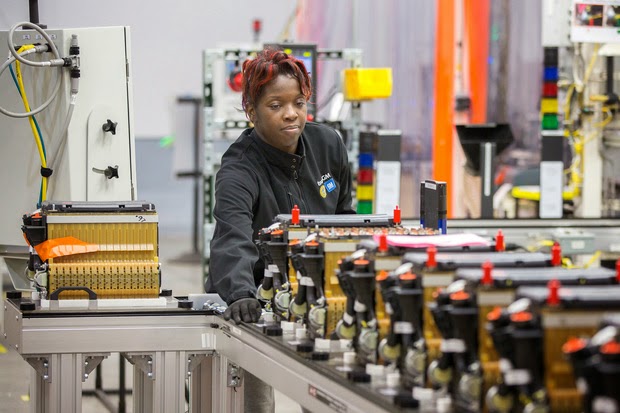Maybe GM doesn’t appear serious about electric cars because the Chevy Spark EV cannot be built in large quantity because of A123 Systems? The other day I wrote that GM doesn’t appear to be too enthusiastic about electric cars because Volt sales are more anemic than they should be, and the Spark EV is being made in tiny quantities. GM’s announcement today about bringing Spark EV battery pack production in-house is making me rethink that theory. Maybe, oh maybe, the troubles at A123 Systems made it impossible for GM to build the Spark EV in large quantity?
Actually, that’s not the case, because the decisions on the Spark EV were made before A123 Systems imploded. Let’s go over both parts of this.
The Spark EV is an electric version of the Chevy Spark. That car is made by GM’s subsidiary in Korea, and is a popular car around the world. The gasoline version is sold in the U.S. as well as abroad. The EV version is being sold only in California and Oregon, and GM is limiting production (hence sales) to a tiny amount.
GM, as do the other automakers, has to acquire from somewhere enough ZEV credits to be able to continue selling gasoline powered cars in California. Spark EV sales earn more credits per car than do Volt sales.
Famously, A123 Systems was in the running to build battery cells for the Chevy Volt. At the time A123 Systems was a darling of the cleantech startup companies. I think Google even invested in the company.
A123 Systems’ implosion
Since there’s some confusion about A123’s implosion, let me summarize. A123 Systems developed one of the first implementations of the Lithium Iron Phosphate battery technology. While LiFePO4 batteries aren’t so great at energy density (kilowatt-hours per kilogram or per liter of volume) they are extremely safe. Further, A123 Systems was able to ensure their cells could withstand high discharge rates.
As a startup company, the company had no track record especially in producing automotive grade cells. When GM designed the Volt, they looked at all the battery cell makers to see who would win the cell supply deal. A123 Systems was on the list, but at the end of the day GM went with LG Chem in part because LG Chem is a tried-and-true battery manufacturer.
A123 Systems eventually landed a deal with Fisker Automotive for supplying complete battery packs. They also landed a deal with GM on supplying either complete packs or cells for the Chevy Spark EV.
Why A123 Systems imploded is a complex story which I wrote up elsewhere. Basically – they made a business mistake, overly relying on a single customer (Fisker) – they didn’t catch QA problems in the battery packs, but instead Fisker found those problems – the problems led to a recall effort, the expense of which blew a hole in A123’s financial well-being – etc
A123 Systems, LLC was created by Chinese autoparts maker Wanxiang after they bought most of A123 Systems, Inc’s assets out of bankruptcy.
Getting back to the Spark EV
What GM announced today is that, working with LG Chem, battery packs for the 2015 Chevy Spark EV will be built at GM’s Brownstone factory. “Using our in-house engineering and manufacturing expertise enabled us to deliver a battery system that is more efficient and lighter than the 2014 Spark EV without sacrificing range,” said Larry Nitz, executive director of GM global transmission and electrification engineering. “Our successful working relationship with LG Chem has allowed us to deliver a new battery system for the Spark EV that helps us to better leverage our economies of scale.”
A123 Systems, LLC, is losing out here. LG Chem is winning.
The new pack holds 19 kilowatt-hours in 192 cells, for a total weight of 474 lbs. This is 86 lbs lighter than the packs A123 Systems supplied to GM.
The change won’t affect the 2015 Spark EV’s range or efficiency ratings from the EPA. It’ll still be rated for 82 miles of range, and fuel efficiency equaling 119 MPGe.
LG Chem builds the cells at a factory in Michigan – built with some federal loans. Ford also gets cells from LG Chem from the same factory, reportedly.
GM has long expressed a belief that just as automakers must have engine building expertise today, automakers of the future must have expertise in-house in building and designing battery packs. In-house’ing Chevy Spark EV battery pack production fits that vision.
- Highway design could decrease death and injury risk, if “we” chose smarter designs - March 28, 2015
- GM really did trademark “range anxiety”, only later to abandon that mark - March 25, 2015
- US Government releases new regulations on hydraulic fracturing, that some call “toothless” - March 20, 2015
- Tesla Motors magic pill to solve range anxiety doesn’t quite instill range confidence - March 19, 2015
- Update on Galena IL oil train – 21 cars involved, which were the supposedly safer CP1232 design - March 7, 2015
- Another oil bomb train – why are they shipping crude oil by train? – Symptoms of fossil fuel addiction - March 6, 2015
- Chevron relinquishes fracking in Romania, as part of broader pull-out from Eastern European fracking operations - February 22, 2015
- Answer anti- electric car articles with truth and pride – truth outshines all distortions - February 19, 2015
- Apple taking big risk on developing a car? Please, Apple, don’t go there! - February 16, 2015
- Toyota, Nissan, Honda working on Japanese fuel cell infrastructure for Japanese government - February 12, 2015



















